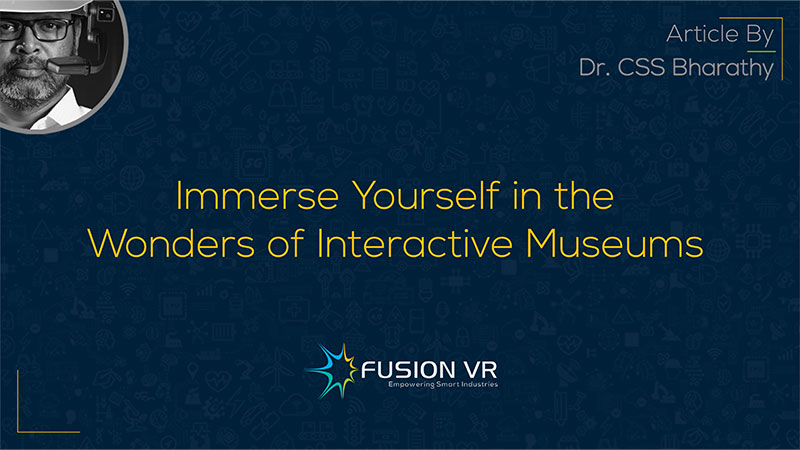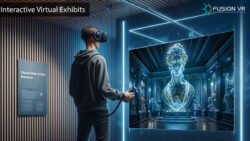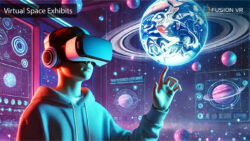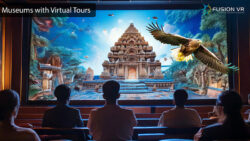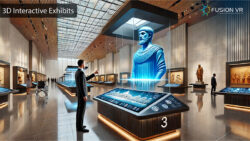In recent times, museums have undergone tremendous transformations, especially with the advent of interactive technologies that have helped to enhance and widen visitors’ experience. Having expertise in this evolving industry, Fusion VR can help in terms of changing traditional museum visits through the integration of such technological, cultural, and historical advancements into opportunities for immersive learning. These interactive museums have come out of the bondage of digital displays along with implementing technologies such as virtual reality, augmented reality, and so on. In other words, audiences belonging to all age groups are attracted to this vibrant and innovative experience.
Digital museums attract audiences with interactive experiences, powered by many digital technologies. One of the most exciting facilities in such places is VR experience centers, where one gets teleported into other eras and locations virtually. Using this technology, learning can turn out to be empowering and exciting while studying major events in history or some cultural locations and events! For example, it is now possible, with the convenience of a digital museum, to walk virtually through historic cities or experience historical events unfold in front of one! Such Immersive experiences have special values in an educational setting since they enable a greater perception and recall of the matter at hand.
Fusion VR has created some wonderful projects that bring out, quite vividly, the potential of VR and AR as very strong tools of storytelling and education. It is in remembrance of the life and works of the late Dr. J. Jayalalithaa towards Tamil Nadu and India. In this advanced digital exhibited museum, every bit of her life is interactively viewable by visitors for them to comprehend her politics, social activities, and personal story. This project demonstrates how technology can be used to create very powerful storylines that speak to each visitor individually, thereby creating an experience all its own.
Apart from cultural and historical experience events, Fusion VR has expertise in the development of corporate experience centers. Enhanced with virtual tours, interactive displays, and immersive storytelling, corporate experience centers have become much efficient in communication and branding. They offer a unique way for businesses to engage stakeholders, employees, and visitors by giving a detailed and interactive insight into the values and goals of the company. This could be, for example, a virtual reality tour through the production process of a company, an interactive timeline of milestones, or some form of virtual product presentation that may better realize the brand and connect it with the visitor.
One of the most significant contributions that these technologies can make to museums and experience centers is that of accessible experiences, previously out of reach for so long to people around the world. The digital and virtual museums make exhibitions and collections available non-geographically so that everybody from across the world can look through and surf through extensive displays otherwise not accessible to many people. This in itself is a gigantic achievement in democratization providing enormous access to educational material and cultural heritage. It’s something that Fusion VR initiatives, from Chronicles India to the ImmeX Zone, are only too happy to demonstrate.
The Chronicles India Project hosts a 7DX experience theatre tracing the history of the Pallava dynasty and taking one on a voyage through the rich tapestry of culture in ancient India. This initiative does not only entertains but also educates visitors by giving them a comprehensive coverage of the entire journey of India’s history in an interesting and informative way.
But more importantly, beyond the experience of the visiting audience, technology such as VR and AR being put into museums is of prime importance to the preservation and sustainability for cultural assets. Digital copies and virtual exhibitions thereby provide an answer for preserving the integrity of light or sensitive items from physical damage while ensuring future generations can savor them. In addition, virtual exhibition content is much easier to update and modify than traditional displays and makes them very flexible and cost-effective to manage. In the modern world of constant change, a museum should be adaptive, with updates to new offerings so that it can remain relevant and socializing.
An important advantage of interactive museums is the use of data analytics for personalization and the continuous upgrading of visitor experiences. It can be designed by collecting data on different interactions and visitor preferences to understand what seems to work and what should be changed. This allows these institutions to use data for enhancing exhibits and events according to the needs and interests of audiences, in that way it provides an upcoming experience in a unique and enjoyable way to please visitors.
Finally, the transformation of the traditional museum into an interactive and immersive museums gives a new dimension to the understanding of culture, heritage and its learnings. Fusion VR’s work in this area greatly exemplifies how technologies from VR and AR can build an interesting, instructive, and available experience into a greater level. Whether it’s examining the analytical data in a VR experience center or engaging with exhibits in a corporate experience center, the advancement of history, culture, and technology opens up new opportunities. This fusion of technology and culture not only fosters appreciation, but also enhances our understanding of the past, offering fresh avenues for education and exploration to everyone globally.

